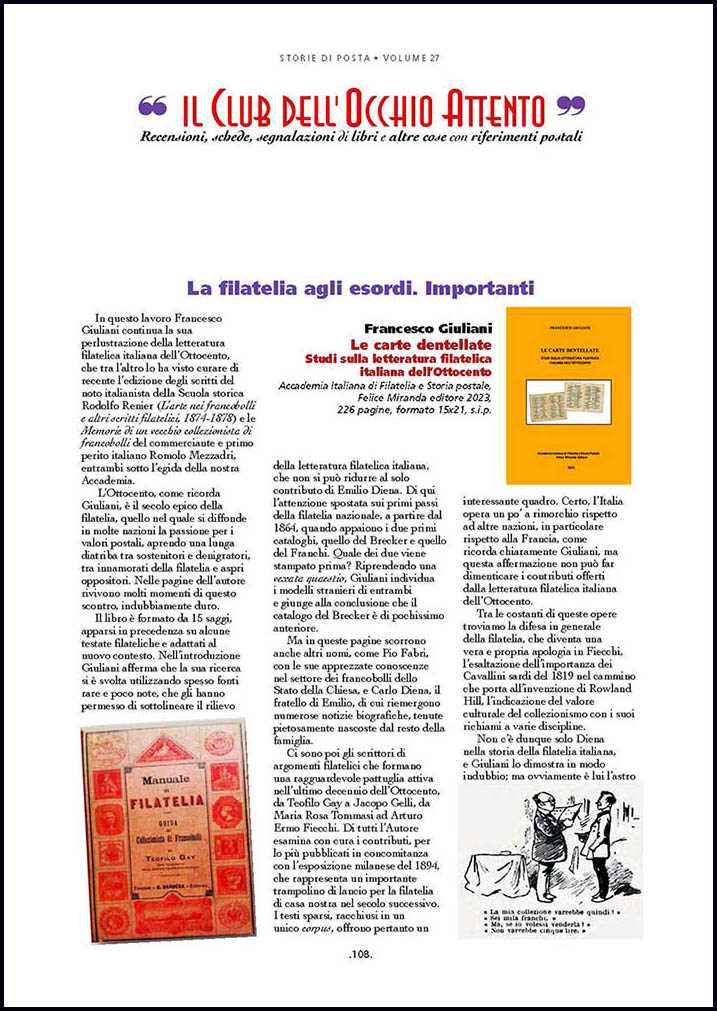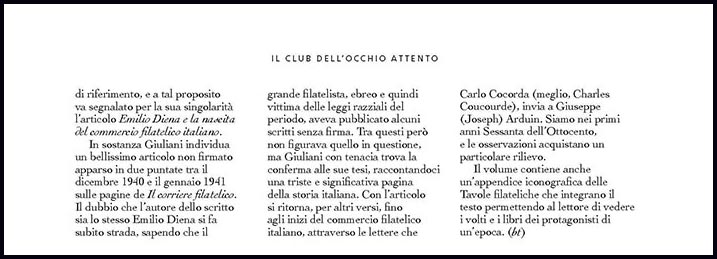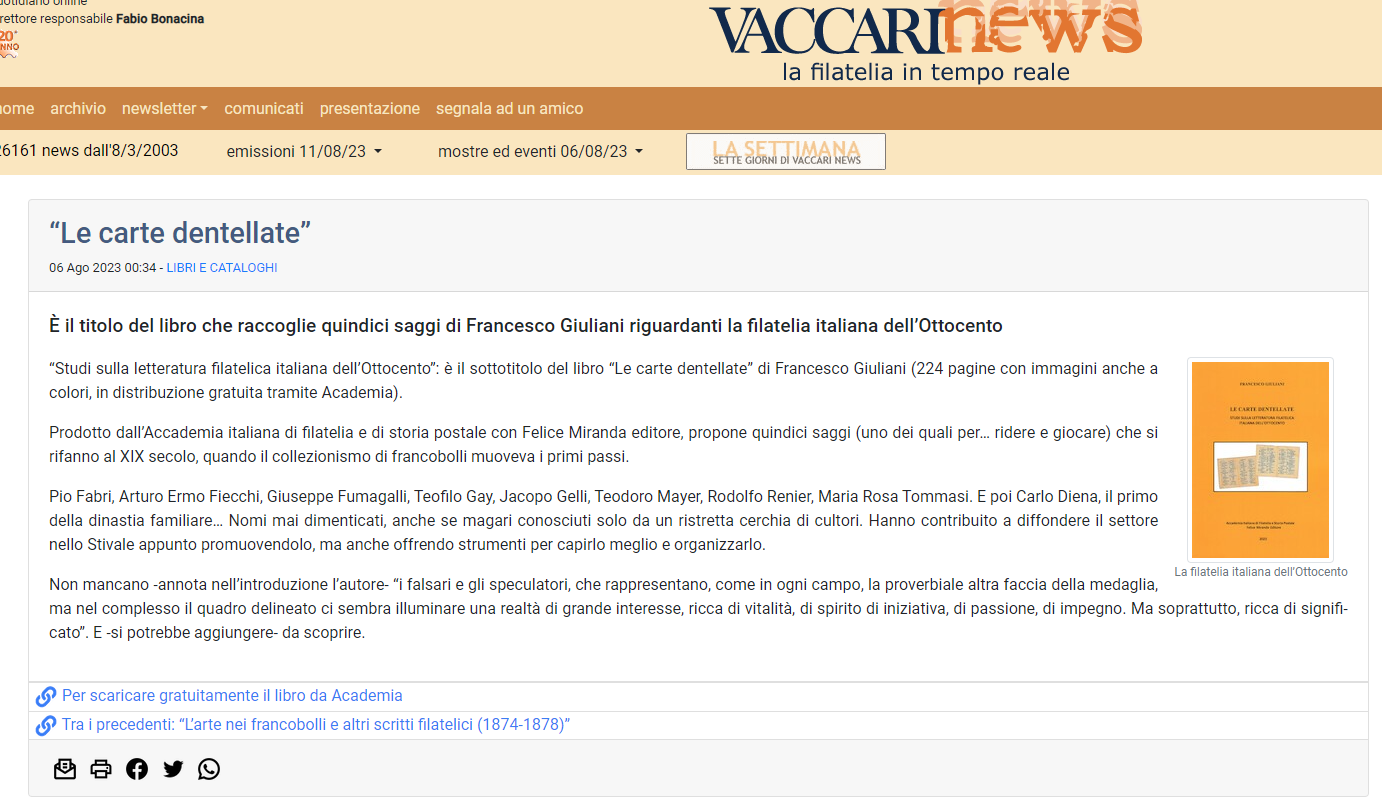
Storie di Posta, n. 27, maggio 2023, pp. 108-09


.............................................
FIL-ITALIA, VOL. XLIX, n. 2, SPRING 2023, pp. 96-97
Francesco Giuliani - “Le Carte Dentellate – Studi sulla letteratura
filatelica dell’Ottocento” (The Perforated Papers. Studies on the Italian
Philatelic Literature of the 1800s) - Perfect bound, 224 pages (8¼”x12”) replete
with black and white illustrations, in Italian, ISBN: 978-88-947321-0-8 - Felice
Miranda Editore 2023, available for free download at Academia. Edu or from il
Postalista https://www.ilpostalista.it/,
alternatively from the author
fransgiulio@gmail.com at €20.
In his introduction the author explains that “The nineteenth century
is the century that saw the birth of philatelic collecting, the epic period par
excellence, with undoubted charm. After a timid start, at the beginning of the
1860s the more advanced nations saw an explosion of passion for philately
including books, catalogues, magazines, price lists, exchange and commerce
networks. For the many opponents, who will never fail, even in more recent
years, it’s a kind of mania, a form of collective madness, which is unnaturally
linked to the much more concrete Rowland Hill innovation, successfully adopted
by a growing number of nations. For others, however, philately is one passion, a
hobby, a trade, which in some reveals a deep bond with culture, so much so that
it becomes, if you think about it well, an eloquent metaphor for existence.”
Professor Giuliani is rather vocal about the helpful role played by
the internet where it is increasingly easy to retrieve and read from your home
what not too long ago was only available at libraries. The advantages foremost
the trump card of reading about what contemporaries knew about philately and
what they thought about it. As a result the author says “We thus come across
texts that confirm the cultural depth of this form of collecting, which
throughout the world has produced an impressive number of titles of all genres”.
In recent years Giuliani has shared what he has learned about the
pioneers of philately who operated in Florence, Turin, Rome, and Bologna through
articles published by philatelic periodicals of our century. As a result he has
paid attention to the philatelic catalogs of Brecker and Franchi, to the
monograph of Pio Fabri on the postage stamps of the State of the Church, to
philatelic works of the young Teodoro Meyer, to the writings of personalities of
substance who have operated in other areas, but have not disdained forays into
the world of philately, like Giuseppe Fumagalli and Jacopo Gelli, who sided with
cognoscenti like Rodlfo Renier.
In this world Emilio Diena soon became a beacon of undeniable
reliability and prestige at a global level, remembering other things as well as
painful events such as the racial laws and the existence of a documented study
on origins of the philatelic trade, in the 1860s, appeared unsigned between 1940
and 1941.
In the fifteen chapters that follow we learn about forgers and
speculators, representing, as in every field, the other side of the coin, but
overall the picture outlined seems to illuminate a reality of great interest,
rich in vitality, spirit of initiative and passion, of commitment. But above
all, rich in meaning. In short, these pages, which Giuliani delivers to the
attention of the benevolent reader, offer knowledge about a period of philatelic
collecting and, at the same time, facilitate in some form that ‘search for
meaning’ that must always be to the basis of philatelic collecting.
This volume is indispensible for those who want to start ab ovo
usque ad mala namely, at the origins of philately in an unbiased mode,
without compromises and grey zones.
After this unequivocal introduction we learn about the birth of the
first stamp handbooks in 1864 preceded by those published in France, Great
Britain and Germany. Italy made its debut in philatelic literature in 1864 when
two handbooks, the Guide to all Stamps by Joseph Brecker, and the
Handbook on how to build a stamp collection, which on its cover does not
show the name of the author: Ulisse Franchi.
To our eyes these handbooks are two short catalogues, which are
closely linked to the commercial activity of the authors. The place of
publication, in both cases, is Florence, home of the Italian language, which the
following year will become the provisional capital of the Kingdom of Italy.
These catalogues were surrounded by a sort of halo of mystery, for a very simple
reason, namely that very few collectors had them in their hands. Brecker’s
catalogue is rare, but that of Franchi’s is even more so. Their sources of
information were respectively in German and in French.
The 1870s Florence continued in its philatelic pioneer role. in 1872
Elia Carlo Usigli published his innovative New Catalogue of stamps, revenue
stamps and artistic and iconographic curiosities – a veri rare
book to find. Usigli enjoyed some notoriety, but on his dark side he sold
forgeries. To keep his customers ut to date he published a quarterly titled
Il Raccoglitore (The Collector).
Teodoro Mayer, born in Trieste in 1860 from a Jewish family, and
founder in 1881 of the local daily newspaper ‘Il Piccolo’. He cutivated Masonic
and political contacts in Rome. In 1902 he bought half of the shares of the news
agency Stefani; in 1920 he became senator. However, all of these achievements
did not protect him against the 1938 racist laws that resulted in Mayer being
removed from any public position and depriving him from owning the daily
newspaper. He died four years later in Rome.
Trieste was a lively business town since the days when it was part of
the Austro-Hungarian empire; 1866 saw the debut of philatelic periodical in
German. In 1875 Mayers started to publish an Italian version under the name ‘Il
corriere dei francobolli’.
The 1870s saw the publication of the firs italian philatelic monthly
magazine ‘La Posta Mondiale’ which had only 12 issues between 1873 and
1874. In July 1876 ‘The Illustrated Philatelic Guide’ makes its debut in
Bologna; during its first five years the publication saw various changes. The
names of the people involved in this philatelic venture included Carlo Diena,
Icilio Arturo Loli, Francesco Mignani and Francesco Carlo Tonolla, all of them
directly involve in the stamp business.
The most prominent name is Giuseppe Leoni, executive chief editor and
in some periods also owner of the masthead, which began as a philatelic trader,
and then focused in the field of journalism. His signature is found on the
issues of the entire series, from July 1876 until December 1880.
The firs philatelic monograph ‘The first stamps of the State of the
Church’ was written by Pio Fabri and published by J.B. Moens in 1878. This
very active publisher went on to publish small volumes devoted to the stamps of
the Italian States and San Marino.
The chapter that conclude this useful book focus on the major
publications of Italian experts and specialists from Giuseppe Fumagalli, Teofilo
Gay, Maria Rosa Tommasi, to Jacopo Gelli, Arturo Ermo Fiecchi, Vittorio Imbriani,
as well as the greatest of all, Emilio Diena under whose masterful guidance
Italy saw the publication of the ‘Victory Catalogue’ in 1923 which had a
text highlighting the valued scientific dimension of collecting stamps with a
resolute and courageous choice, this in highlighted flawlessly in the Preface:
“Those who unfortunately are the majority in Italy – who delude themselves to
provide an exact order of their collections following the weak footsteps marked
by price lists and catalogues published with commercial intentions, have only to
continue in their way, if they so choose, without consulting or monographs,
neither the special catalogues nor the best periodicals, and sometimes ignoring
their existence. Our task was t mark them a very differentr path.”
Giuliani’s newest book will remain a reference work for generation to
come; its digital version can be retrieved at no cost and readers are invited to
take advantage of such a generous offer. On the other hand, it would be wise
also to buy the hard copy.
GIORGIO MIGLIAVACCA
